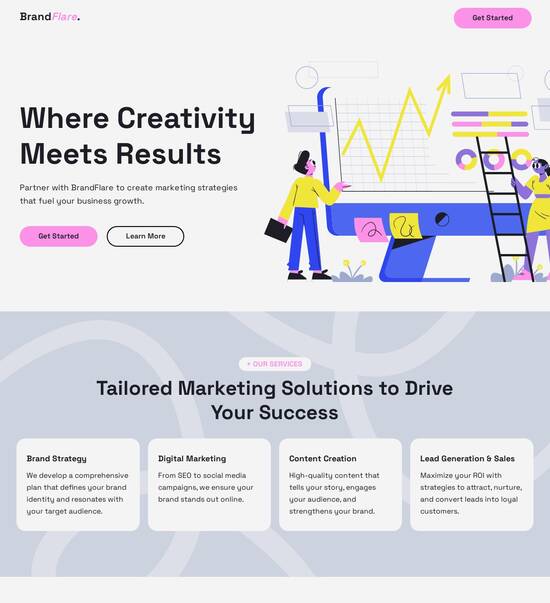
Next.js optimized timeline page template
Explore Similar TemplatesAbout template
Supercharge your timeline page with Next.js for outstanding performance! Learn more today.
Recommended templates

Easy to build without coding
With the intuitive drag-and-drop builder, anyone on your team can create high-converting pages without any knowledge of code or design. Make enhancements to your landing page with custom widgets using Javascript, HTML/CSS, or third-party scripts.

Multiple layouts for any industry and goal
Select from 500+ landing page layouts built to boost conversions across industry-specific scenarios. Customize them by adjusting fonts, adding images, and generating on-brand content with the AI assistant. Quickly scale with Instablocks® and Global Blocks that you can save, reuse, and update globally.

Loads fast and looks polished on any device
Every template is responsive, which means they present professionally on any device and load blazingly fast with our Thor Render Engine. You can also power them up with Google AMP technology to deliver an unparalleled mobile experience and drive higher conversions.

Robust analytics & experimentation
Get real-time updates and reporting across all your devices, showing the number of visitors, conversions, cost-per-visitor, and cost-per-lead. Launch AI-powered experiments, run A/B tests, and use heatmaps to analyze user behavior, then optimize your landing page to maximize conversions.







Easy to build without coding
With the intuitive drag-and-drop builder, anyone on your team can create high-converting pages without any knowledge of code or design. Make enhancements to your landing page with custom widgets using Javascript, HTML/CSS, or third-party scripts.
Multiple layouts for any industry and goal
Select from 500+ landing page layouts built to boost conversions across industry-specific scenarios. Customize them by adjusting fonts, adding images, and generating on-brand content with the AI assistant. Quickly scale with Instablocks® and Global Blocks that you can save, reuse, and update globally.
Loads fast and looks polished on any device
Every template is responsive, which means they present professionally on any device and load blazingly fast with our Thor Render Engine.
Robust analytics & experimentation
Get real-time updates and reporting across all your devices, showing the number of visitors, conversions, cost-per-visitor, and cost-per-lead. Launch AI-powered experiments, run A/B tests, and use heatmaps to analyze user behavior, then optimize your landing page to maximize conversions.
All the features you need to build lead-generating landing pages
Explore more featuresLearn how to build top-performing landing pages for any goal
FAQs
Leading the way in building high-performing landing pages





An essential guide to Instapage, the most powerful landing page and CRO platform
Instapage offers an unparalleled solution for marketers aiming to optimize their landing pages and enhance their conversion rates. With its suite of tools, marketers across various industries such as business services, tech, education, and finance can accelerate their campaigns effectively.
Understanding the importance of landing pages
Landing pages are vital for any digital marketing campaign as they serve as the first point of interaction between potential customers and your product or service. By utilizing Instapage’s intuitive platform, users can create pages that are designed for high conversion rates quickly and without the need for coding skills.
- High-converting templates: Instapage provides over 100 ready-to-use templates tailored to different industries, ensuring your landing page can captivate visitors instantly.
- Lead generation elements: Built-in features allow for effective lead capture, transforming page visitors into actionable leads.
- Ease of use: Non-technical users can build stunning landing pages using drag-and-drop functions, enhancing productivity without a steep learning curve.
Creating compelling content for your landing pages
Content is king, especially on landing pages. By personalizing your copy and visuals, Instapage lets you dynamically serve targeted messaging that resonates with specific audience segments.
- Dynamic text replacement: Instantly adjust your messages based on user demographics for a more personalized experience.
- Ad alignment: Instablocks help ensure your landing pages are directly relevant to your ad campaigns, improving the likelihood of conversion.
- Audience-level metrics: Track how individual segments respond to variations in your content, allowing for precise optimization.
Optimizing landing pages for superior results
To maximize ROI, continuous optimization is critical. Instapage includes advanced features for A/B testing, heatmap analysis, and performance analytics that empower marketers to refine their pages effectively.
- A/B testing: Easily set up tests for different versions of your landing pages to discover what resonates best with your audience.
- Heatmaps: Visualize where users click and how they navigate on your pages, providing insights to inform design changes.
- Analytics dashboard: Get a comprehensive overview of your campaign performance with real-time metrics and reports.
Implementing these optimization techniques consistently is key to driving higher conversions and maximizing campaign effectiveness.
With Instapage, marketers have the capability to transform their campaigns by leveraging powerful tools that enhance every aspect of landing page performance.
Ready to optimize your marketing strategy? Explore Instapage today and start creating high-converting landing pages that maximize your ROI.
Unlocking the potential of Next.js: An optimized timeline page template
Understanding timelines in web development
Timelines are visual representations that convey events or data points over a specified period. In web development, they serve as intuitive interfaces that help users grasp complex sequences and relationships between various moments. Whether it’s project milestones, historical events, or personal achievements, timelines allow for clear communication and engagement.
Visualizing milestones and events is crucial in numerous contexts, especially where chronological order impacts understanding. For instance, consider educational websites that showcase historical timelines or project management platforms illustrating phases of a project. A well-designed timeline can enhance the user's grasp of information, making it easier to digest.
Increases user engagement by providing a clear visual flow.
Helps to contextualize information within a timeframe.
Encourages interaction, as users can navigate through different events.
Case studies illustrate the effectiveness of timelines in various applications. For instance, a SaaS product may exhibit user journey timelines to highlight feature advancements or updates. The expected user experience with timeline interfaces should be one of clarity, interactivity, and informational richness.
The Next.js framework: a deep dive
Next.js is a powerful React framework designed for building high-performance web applications. Its features include Server-Side Rendering (SSR) and Static Site Generation (SSG), which ensure fast load times and improve SEO. By pre-rendering pages, Next.js can serve users with faster experiences, a critical factor in keeping them engaged.
Another noteworthy feature is automatic code splitting, where only the necessary JavaScript is loaded for the current page, optimizing the speed and responsiveness of web applications. Additionally, dynamic routing allows for the building of scalable applications by creating routes based on the content, thus simplifying navigation through a timeline interface.
Seamless integration with the existing React ecosystem.
Enhanced performance through built-in optimizations.
Improved SEO capabilities via pre-rendering.
Choosing Next.js for building timeline pages offers a solid foundation for developers. With its advanced features and community support, it provides the tools needed to create interactive and visually appealing timelines that can cater to modern user demands.
Constructing a robust codebase for a timeline page
Creating a timeline page with Next.js begins with a well-structured codebase. Setting up the project involves organizing file components effectively. Typically, you'll find directories for pages, components, and styles, ensuring a clean separation of concerns. Managing dependencies through tools like npm ensures that your application has the necessary libraries for success.
A modular and scalable codebase allows for easier updates and maintenance. By building reusable UI components such as event cards, milestone indicators, and interactive navigation elements, developers can enhance productivity and consistency across the application. Each component should be self-contained, making it easy to integrate and adjust as required.
Event cards that display essential details at a glance.
Milestone indicators for a quick visual reference of key points.
Interactive navigation elements to help users explore the timeline effortlessly.
Incorporating TypeScript into the development process brings strong typing and predictability, reducing bugs and enhancing code readability. This additional layer of type safety is particularly useful in larger projects where managing state and props can become complex.
UI components: crafting a user-centric experience
The user experience (UX) and user interface (UI) design are crucial aspects when creating timeline pages. A good UI should ensure that users can intuitively navigate through the timeline while effectively interpreting the represented data. Key components of this interface include header and footer elements, interactive timeline bars, and representations of milestones and events.
The header often reflects branding, while the footer might house important links or information. Interactive timeline bars provide visual pathways for exploration, allowing users to click on events for a deeper dive into details. Representations of milestones create a clear structure that guides users’ journeys through the timeline.
Implement responsive design principles to ensure usability across devices.
Stay mindful of accessibility considerations to include all users.
Ensure a consistent aesthetic that aligns with your brand.
Best practices in UI design involve maintaining clarity, simplicity, and responsiveness. As users interact with the timeline, ensuring that it adapts and responds fluidly on different screen sizes is paramount. Furthermore, paying attention to accessibility will enhance the experience for users with disabilities.
The significance of engagement metrics
Engagement metrics play a vital role in understanding user interaction with timeline pages. By tracking how users navigate through the timeline, which events catch their attention, and where they may drop off, developers can gather valuable insights to refine and improve the user experience. Tools like Google Analytics and heatmaps can provide an overview of these interactions.
Moreover, measuring engagement helps in tailoring content to better meet the needs and preferences of users. For instance, if certain milestones see higher interaction rates, developers can analyze why and consider highlighting similar events or formats elsewhere on the timeline.
Track user clicks, hovers, and time spent on each event.
Use A/B testing to determine which timelines perform best.
Regularly revise your UX/UI based on user feedback and data.
Interpreting data gathered through engagement metrics can steer future development. This iterative feedback loop is essential for the evolution of timeline interfaces, ensuring that they remain relevant and attentive to user needs.
Streamlining end development with Next.js
To streamline development, setting up effective development and testing environments is crucial. Next.js supports hot reloading, making it easy to see changes in real time without rewriting code. This feature accelerates the development process and allows for immediate feedback, essential for agile methodologies.
Leveraging built-in development tools such as ESLint and TypeScript can help maintain code quality. Developers can also utilize debugging features to troubleshoot errors efficiently. Strategies for collaboration become vital in projects, where developers can use version control systems like Git to track changes and communicate their workflows.
Set up a structured folder architecture to enhance clarity.
Use ESLint to standardize code across the team.
Utilize Git hooks for workflow automation.
Continuous deployment and monitoring ensure that the timeline page remains updated and functional after launch. By integrating CI/CD pipelines, developers can automate the deployment process and catch issues early, which can significantly enhance the project's longevity.
Contextualizing user data
Understanding user rights and compliance is essential when handling user data in timeline pages. Whether it's through a privacy policy or terms of service, being transparent about data usage fosters trust. User consent management is also vital, especially regarding event tracking and data collection.
Moreover, ethical considerations should remain at the forefront of data handling practices. Maintaining user privacy and ensuring compliance with regulations such as GDPR not only protects users but also enhances brand reputation.
Ensure compliance with local laws concerning data protection.
Implement clear policies on how user information is used.
Promote ethical data practices throughout the development team.
Effective contextual user engagement relies on a solid understanding of these principles. By creating environments that respect user privacy, development teams can build applications that users trust and enjoy using.
Workflow for building a timeline page template
Establishing a clear workflow for developing a timeline page template is key to its successful implementation. This involves defining project milestones and key deliverables upfront, allowing teams to stay focused and on track throughout the development cycle. Using project management tools like Trello or Asana can significantly enhance this process.
Integrating feedback loops into the workflow allows for iterative improvements, ensuring the final product aligns with user expectations. Collaboration tools such as Slack and GitHub facilitate communication among team members, enhancing transparency and reducing misunderstandings.
Outline project phases and expected outcomes.
Gather feedback regularly to refine the design and functionality.
Utilize task management software to track progress and assignments.
Examples of effective workflow strategies include Agile methodologies, which promote flexibility and quick iterations. By maintaining a fluid approach to development, teams can better respond to changes and new requirements.
Challenges and solutions in timeline implementation
While developing a timeline page offers numerous benefits, it also presents its own set of challenges. Performance issues can arise, especially with large datasets, leading to long load times. Optimizing assets and implementing lazy loading techniques can significantly mitigate these concerns.
Another common pitfall is ensuring responsiveness across different devices. Utilizing CSS frameworks like Tailwind CSS can assist in creating flexible layouts that adapt seamlessly to various screen sizes. Additionally, effective debugging techniques such as using dev tools and console logging can help pinpoint issues quickly.
Regularly audit performance to identify bottlenecks.
Implement responsive design to enhance user experience on all devices.
Plan for long-term maintenance and scalability from the onset.
Thinking ahead about long-term maintenance and features can ensure that the timeline remains relevant. As user needs evolve, so too should the applications built to serve them.
Closing thoughts: transforming web experiences with timelines
The potential of Next.js in creating engaging timeline interfaces is undeniable. With its robust features and unmatched performance capabilities, developers are well-equipped to enhance user experiences in innovative ways. As web technologies continue to evolve, we can anticipate exciting advancements in interactive components, including timelines.
Innovations such as AI-driven personalization and more immersive visualizations are likely to shape the future of web design. Moreover, the role of timelines in web design and user engagement will only expand, especially as more industries seek to convey information in digestible formats.
Leverage new technology to enhance user engagement.
Invest in research and user testing to anticipate needs.
Stay updated with trends to remain competitive in the market.
In conclusion, the journey of optimizing timeline pages in Next.js is an exciting opportunity for developers. As timelines become integral to web experiences, their design and implementation will continue to evolve, paving the way for richer, more engaging interactions.
Ready to skyrocket conversions?
Supercharge your ad campaigns with high-performing landing pages
Get started














